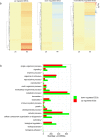Transcriptome Sequencing in Response to Salicylic Acid in Salvia miltiorrhiza
- PMID: 26808150
- PMCID: PMC4726470
- DOI: 10.1371/journal.pone.0147849
Transcriptome Sequencing in Response to Salicylic Acid in Salvia miltiorrhiza
Abstract
Salvia miltiorrhiza is a traditional Chinese herbal medicine, whose quality and yield are often affected by diseases and environmental stresses during its growing season. Salicylic acid (SA) plays a significant role in plants responding to biotic and abiotic stresses, but the involved regulatory factors and their signaling mechanisms are largely unknown. In order to identify the genes involved in SA signaling, the RNA sequencing (RNA-seq) strategy was employed to evaluate the transcriptional profiles in S. miltiorrhiza cell cultures. A total of 50,778 unigenes were assembled, in which 5,316 unigenes were differentially expressed among 0-, 2-, and 8-h SA induction. The up-regulated genes were mainly involved in stimulus response and multi-organism process. A core set of candidate novel genes coding SA signaling component proteins was identified. Many transcription factors (e.g., WRKY, bHLH and GRAS) and genes involved in hormone signal transduction were differentially expressed in response to SA induction. Detailed analysis revealed that genes associated with defense signaling, such as antioxidant system genes, cytochrome P450s and ATP-binding cassette transporters, were significantly overexpressed, which can be used as genetic tools to investigate disease resistance. Our transcriptome analysis will help understand SA signaling and its mechanism of defense systems in S. miltiorrhiza.
Conflict of interest statement
Figures





Similar articles
-
Transcriptional data mining of Salvia miltiorrhiza in response to methyl jasmonate to examine the mechanism of bioactive compound biosynthesis and regulation.Physiol Plant. 2014 Oct;152(2):241-55. doi: 10.1111/ppl.12193. Epub 2014 May 12. Physiol Plant. 2014. PMID: 24660670
-
Comprehensive transcriptome profiling of Salvia miltiorrhiza for discovery of genes associated with the biosynthesis of tanshinones and phenolic acids.Sci Rep. 2017 Sep 5;7(1):10554. doi: 10.1038/s41598-017-10215-2. Sci Rep. 2017. PMID: 28874707 Free PMC article.
-
[Regulation effects of intracellular and extracellular Ca2+ on biosynthesis of rosmarinic acid induced by salicylic acid in young seedlings of Salvia miltiorrhiza].Zhongguo Zhong Yao Za Zhi. 2013 Oct;38(20):3424-31. Zhongguo Zhong Yao Za Zhi. 2013. PMID: 24490547 Chinese.
-
[Salvia miltiorrhiza as medicinal model plant].Yao Xue Xue Bao. 2013 Jul;48(7):1099-106. Yao Xue Xue Bao. 2013. PMID: 24133975 Review. Chinese.
-
Salicylic acid beyond defence: its role in plant growth and development.J Exp Bot. 2011 Jun;62(10):3321-38. doi: 10.1093/jxb/err031. Epub 2011 Feb 28. J Exp Bot. 2011. PMID: 21357767 Review.
Cited by
-
Systematic Analysis of Alkaline/Neutral Invertase Genes Reveals the Involvement of Smi-miR399 in Regulation of SmNINV3 and SmNINV4 in Salvia miltiorrhiza.Plants (Basel). 2019 Nov 11;8(11):490. doi: 10.3390/plants8110490. Plants (Basel). 2019. PMID: 31717988 Free PMC article.
-
Genome-Wide Characterization and Analysis of the bHLH Transcription Factor Family in Suaeda aralocaspica, an Annual Halophyte With Single-Cell C4 Anatomy.Front Genet. 2022 Jul 7;13:927830. doi: 10.3389/fgene.2022.927830. eCollection 2022. Front Genet. 2022. PMID: 35873472 Free PMC article.
-
Combined Analysis of the Metabolome and Transcriptome Identified Candidate Genes Involved in Phenolic Acid Biosynthesis in the Leaves of Cyclocarya paliurus.Int J Mol Sci. 2020 Feb 17;21(4):1337. doi: 10.3390/ijms21041337. Int J Mol Sci. 2020. PMID: 32079236 Free PMC article.
-
Biosynthesis and signal transduction of plant growth regulators and their effects on bioactive compound production in Salvia miltiorrhiza (Danshen).Chin Med. 2024 Jul 24;19(1):102. doi: 10.1186/s13020-024-00971-5. Chin Med. 2024. PMID: 39049014 Free PMC article. Review.
-
Transcriptomic Analysis Reveals Candidate Genes in Response to Sorghum Mosaic Virus and Salicylic Acid in Sugarcane.Plants (Basel). 2024 Jan 14;13(2):234. doi: 10.3390/plants13020234. Plants (Basel). 2024. PMID: 38256787 Free PMC article.
References
-
- Kang DG, Oh H, Chung HT, Lee HS (2003) Inhibition of angiotensin converting enzyme by lithospermic acid B isolated from Radix Salviae miltiorrhiza Bunge. Phytother Res 17: 917–920. - PubMed
-
- Zhou L, Zuo Z, Chow MS (2005) Danshen: an overview of its chemistry, pharmacology, pharmacokinetics, and clinical use. J Clin Pharmacol 45: 1345–1359. - PubMed
-
- Yang H, Han L, Sheng T, He Q, Liang J (2006) Effects of replenishing qi, promoting blood circulation and resolving phlegm on vascular endothelial function and blood coagulation system in senile patients with hyperlipemia. J Tradit Chin Med 26: 120–124. - PubMed
Publication types
MeSH terms
Substances
LinkOut - more resources
Full Text Sources
Other Literature Sources

